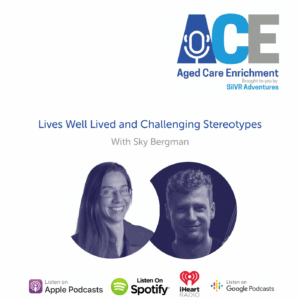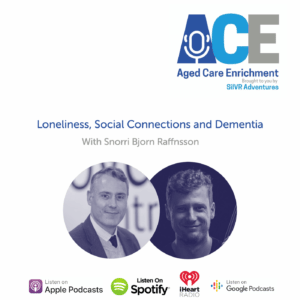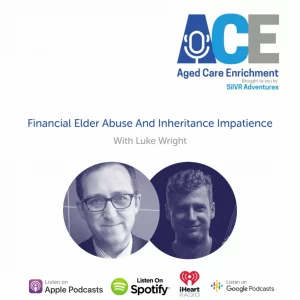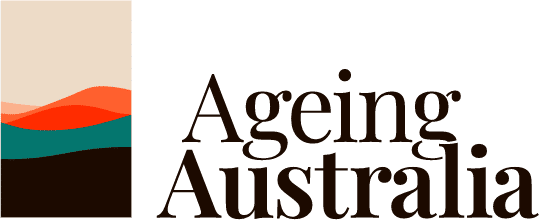Multicultural care is about supporting people in their language, with respect to their customs and culture. It’s not simply the absence of discrimination, but is about providing resources and support so that every person can access high quality care – no matter their heritage.
Joining the podcast this week to talk about multicultural care is Lisa Tribuzio and Niki Rittinghausen from the Centre for Cultural Diversity in Ageing.
A lot of this conversation focuses on how essential interpreting, translating and language appropriate resources are for linguistically diverse older adults, both in home care and residential care. One third of seniors in Australia come from non-English speaking backgrounds. This means that isolation, exclusion and miscommunication due to language are consistent obstacles to overcome when delivering care.
Transcript
Ash de Neef: Great. Well, Lisa and Niki, thank you so much for joining us on the show.
Lisa Tribuzio: Thank you for having us Ash.
Niki Rittinghausen: Thank you very much Ash, it’s a pleasure to be board.
Ash de Neef: Yeah, it’s great to have you guys with us and for a conversation about culture and cultural diversity, we have quite a culturally diverse group here. We’ve got a Tribuzio, a Rittinghausen and a de Neef. These are three quite cultural, interesting names, right?
Lisa Tribuzio: Absolutely. And thank you for the right pronunciation of my surname, which is often mispronounced in the Australian context.
Ash de Neef: What do you normally get?
Lisa Tribuzio: I get Tribiano probably cause people watch a lot of Friends.
Ash de Neef: There’s no “N” in there. They just don’t even read it!
Lisa Tribuzio: Yeah. I get a lot of different things.
Ash de Neef: Niki, do you get a strange pronunciations too?
Niki Rittinghausen: Yeah, I think people, it’s not a very easy name to pronounce. My name is a long name and actually have, four first names, I actually don’t mention them because it gets too complex. But I was just wondering the names of us we have three European countries in there, so we have Holland, we have Italy and Germany.
So yeah, we are part of the good representation of a part of Europe
Ash de Neef: Yeah, absolutely. I understand that you’ve both had a long and winding journey to end up in aged care and to end up the work that you’re doing at the moment. Before we touched on what you’re doing at this time. Can you give us a bit of your background and how you arrived in aged care?
Maybe Lisa, you can start.
Lisa Tribuzio: Yeah. Thanks, Ash. I guess I’ll do a bit of an overview of my career. So it’s been 20 years as a social worker, working in the multicultural sector uh, working directly with people, communities, families and looking at issues related to racism and discrimination.
So over the last five years, I’ve transitioned into diversity advisor kind of roles looking at systemic change. And I worked in disability. And aged care and worked at the NDIA as well as the inclusive strategies team, looking at policies and procedures around inclusive practice for people living with disability.
And then from there now I’ve transitioned into aged care and it’s a really soft spot for me because I’ve witnessed my grandparents and their struggle in the Australian community. Having English as an additional language and really trying to navigate their way through the Australian community and get their rights met. And so I feel it in my heart.
And often my grandfather comes to me when I’m in meetings. Like I get images of him come through. And um, he was in a residential care facility. And I feel that the work that I do is often guided by my heritage.
Ash de Neef: Fantastic. A personal connection there. What about you Niki?
Niki Rittinghausen: Actually maybe I start with my grandmother, just turned a hundred years, very recently. And I always enjoyed, working with seniors and older people, and maybe that comes from my Grandma because we have a very fun relationship. I actually, I started off doing international studies and I came through the multicultural rail if you wish, because I did a bachelor thesis on the origins of multicultural policy in Australia.
And then after my masters, I started working at ECCV the Ethnic Communities Council of Victoria in multicultural ageing. So it was the crossroads of ageing and multiculturalism and that was my role as the aged care policy officer. And I also worked in policy roles in projects in the areas of sectoral development.
And I really enjoyed that cross section between multiculturalism and aged care. And I’ve been since then, and I still, really enjoy it. I think it’s really an interesting field and with so many opportunities. And now I have been working at the Centre with Lisa since August.
Ash de Neef: Yeah, fantastic. It sounds like you’ve both come in from opposite sides there. Niki you’re coming from policy and management and Lisa coming from social work and working with individuals, working together now with the Centre for Cultural Diversity and Ageing. I really want to talk about your
work, but before we get into the specifics, how are we defining cultural diversity?
Niki Rittinghausen: I think it’s really about celebrating multiculturalism because multiculturalism is about celebrating culture diversity And, enabling everyone to, live and express their own culture.
So I think cultural diversity in Australia is very much, I think, linked to multiculturalism. I think they go hand in hand. and multicultural something that really no migrant communities here in Australia they’re fought for when they came, because originally we had the sort of more assimilationist policy in Australia.
And then, you know, with changes with Whitlam, and Fraser and micro communities advocating for change. Multiculturalism came up in Australia.
Also from Canada where at the start it was biculturalism. So I think in terms of multiculturalism, because we have so many ethnic communities here in Australia, I think Australia is really at the forefront of multiculturalism today together with Canada
And I think it’s great that we live in a multicultural society. , You know, most people have.
parent was born overseas or from a migrant background. So I think we are very culturally diverse in Australia. We often don’t recognize it, but we are.
Ash de Neef: To that. Lisa, you mentioned before your, parents and your grandparents experienced an assimilationist sort of society, what was that like for them?
Lisa Tribuzio: Where do I even begin? My grandparents migrated to Australia during the post-World war two migration program that Australia had adopted in relation to labor reasons. And so my grandparents came here and they settled in the Northern region of Melbourne as a lot of Italians did at the time.
And they did the best they could to raise families and to contribute to the Australian community. They worked very hard and they didn’t have English language proficiency. And so I’m really inspired by their resilience to be able to raise families and get employment and to love each other and their grandchildren.
However, as a little girl the experience that I had witnessing my grandfather in a residential care facility was something that I never want to see again, for any other older person to go through.
The language barrier, the lack of cultural sensitivity, the loss of identity. And so, the work that we do is a lot about dignity, integrity and ensuring that people can maintain their culture, their spirituality, and be the best versions of themselves and have positive aging experiences. And unfortunately, I think that the aged care system has a long way to go.
There’s some great examples, good examples out there and good practices. However, because of the inquiry into aged care through the Royal commission we have seen massive issues in the aged care system in relation to cultural sensitivity. And just with all older people that enter into residential care or even home care or CHSP programs, for example, that there’s a lot of more resources that are needed a lot more support.
Ash de Neef: Yeah. Fantastic. Thank you for, outlining what your family has been through there. I guess it, it raises this balance between integrating into a new society, but still holding on to culturally important things and maintaining identity. I imagine the work that you’re both doing at the Centre of Cultural Diversity and Ageing is treading that line a lot.
How do you balance that? Say you’re supporting a family or you’re encouraging a community. How can you balance those two aspects?
Niki Rittinghausen: Yeah, I think it’s important that we don’t come from the perspective, that we are like criticising organisations and saying you’re not able to do this. Because you’re not matter of the fact is that we have one third of seniors from non-English speaking or coaching and linguistically diverse backgrounds.
So it’s not about necessarily criticising providers because, you know, as Lisa said before there’s a lot more work to do to ensure that providers us deliver culturally inclusive care. It’s more about, building the capacity of them, helping them, being that coach, being that trainer or, you know, teaching them how to do it. Because they don’t have either resources or know how to do it.
So it’s really being that supporting or person, or giving that advice. And I think to what Lisa said before, I also get a lot that people ask me “why there are so many people who don’t speak English to have been here for a long time?”
And it’s really about explain a lot of people that, maybe they are a migrant in Australia, but they never really had the opportunity to actually learn English. Maybe there were at home or they were in factories where everybody was speaking in either basic English or a mix of you know – where there were lots of migrants.
And also put yourself in that shoe, if you were, let’s say in China, and you had to navigate the aged care system as a senior, how would it be for you? So I think it’s important talk to people and say, you know, it is a challenge if you don’t speak the language and we always want to be overseas, we always expect everyone to speak English, you know, obviously.
But I think in Australia we have such a diverse fabric of people, so it’s really important to understand and, then there’s also the thing of language reversion when people get older or have dementia.
So I think it’s important to just change that mindset, making people aware that a lot of people, they don’t just speak English even if they have lived in Australia for a long time.
Ash de Neef: I’m wondering here, because we’re talking about a lot about language and not having English as a first language will be a barrier to accessing quality care for older adults. Are there other barriers as well that are worth noting?
Lisa Tribuzio: Thank you, Ash. If we unpack the idea of language services even further, there are other things to talk about in relation to language barriers. So at the moment we have an under utilisation of translating and interpreting services by the aged care sector. Often the children are used as interpreters or family. People are not understanding how to access interpreters. Sometimes we have a lack of interpreters and certain language groups, so some of the smaller emerging languages. And sometimes people don’t feel comfortable with a third party involved in a private and sensitive conversation.
In addition, we have sometimes the way in which we engage multi-lingual workers, and we don’t often support them and credit for the the language skills that they offer into the workplace. So we need to have like language policies that support multi-lingual workers and their rights in the workplace. The aged care sector does not fund translations for government funded aged care providers, and that’s become an issue. So aged care providers have to fund their own translations.
In addition interpreting services are for free for Australian government funded aged care providers however, they’re not for free once an older person gets their home care package. Once they get a home care package, the old person has to use their own funding and their own resources to pay for an interpreter. This goes against the right to commute, which is under the universal declaration of human rights. And of course the universal declaration on cultural diversity. That everyone has the right to express themselves in their preferred language.
And there’s a lot of advocates suggesting that interpreting should be subsidized across all of the consumer pathway within that. Not just in the assessment process and not just in residential care facilities. For example, it should be once they get their package, that if they would like to get a personal care worker, or if they need transport or if they need to link with a social support program for example, that the interpreting there should also be subsidized.
I just wanted to mention some of the issues in aged care in relation to language services.
Niki Rittinghausen: I just want to add as well that, you know, aged care is something that’s not necessarily that some cultures are not familiar with. For example many cultures that’s really the family who cares for the older people. So that having it as a system, as you know, that’s not common in some cultures.
And what Liza talking was about was talking about for both new and emerging communities, also that new emerging community of people who more recently arrived to Australia that they sometimes are a little bit reluctant to take up service. Because either they’re not culturally appropriate or they’re a little bit afraid of of government authority because they have maybe not so good experience in their home countries.
I just wanted to add that the importance of family in some cultures and that people would really prefer that it’s that care through family. But once people come to Australia and their children work, the situation changes and they need aged care services.
Ash de Neef: No, that’s really good to highlight there that if somebody is migrated and have been seeking asylum in Australia or leaving a hostile sort of environment, Their attitude towards receiving services from the government would be quite different to someone who’s grown up in Australia.
I imagine that there’s a sort of an education piece then that needs to go on throughout multicultural communities to educate that it’s safe. It’s okay. This is something we do here. We can help you. How does that process happen?
Lisa Tribuzio: I guess in relation to older people knowing how to make a complaint, a compliment or a feedback to an aged care service that there’s a lot that needs to be done in that space around inclusive consumer feedback mechanisms. And the reason for that is because we have a very low rate of company consumer feedback to the Australian government systems like MyAgedCare or even the Royal commission from culturally and linguistically diverse and faith diverse older people due to a number of barriers, like you mentioned, Ash.
Which is fear of privacy being breached, fear of that. There, if they’re on a temporary visa that their visa might be taken away from them a history of discrimination and giving feedback to government bodies in the past.
And just general intimidation. And also experiencing discrimination in Australia. We need to mention that people have experienced discrimination in the Australian context and racism as well. And so all these factors are in place and of course we’ve got health literacy, disability, English language barriers. Sometimes feedback is through a survey in written form. Sometimes they’re illiterate.
So there’s a number of different factors and in terms of raising awareness of people’s rights and responsibilities, and there are quite a few providers out there that are multicultural organisations and they have a lot of programs to help and empower older people to make a complaint to, or feedback to the system.
In saying that the aged care budget that’s just been announced and the roadmap to the feature of aged care the next five years, suggests a more inclusive approach to consumer voice and consumer participation. So really watch the space.
Ash de Neef: Yeah well, that would be my next question out of the Royal commission’s final report and the government’s proposed five pillars plan. Are we seeing that some of these challenges are being addressed?
Lisa Tribuzio: It’s really hard to answer that because it’s about the future and a vision for a new aged care system. So at the moment we definitely have things like the navigator program that has been introduced that was mentioned in the budget, especially as it relates to special needs groups.
So culturally linguistically and faith diverse older people are situate themselves in the policy framework within the special needs group category under the aged care act. So we know the government has put resources into aged care navigators that speak different languages and to hand hold and help people access my aged care and aged care services, so that’s great to see.
We are in consultation with lots of different providers and the government around making a more inclusive system in relation to governance. So there’ll be a few governance bodies emerging in the near future. And we’re talking about how do we make diversify the government structures. So that’s really interesting as well.
Other recommendations, we know that there’s going to be an aged care act or revised aged care act. So we’re not sure what that’s going to look like, but there has been mention of diversity and inclusion being embedded throughout the act as core business rather than an add on thing to do.
Ash de Neef: Great. So lots of things on the horizon there that could contribute. Niki, did you have something to add?
Niki Rittinghausen: No, I think what I was going to say is in terms of what Lisa mentioned, the aged care diversity framework and the aged care action plans. For example for LGBTQI and for culturally and linguistically diverse people, I think generally that we have that in Australia, I think that’s a great achievement.
Because I think it’s unique in that sense that, you know, a country, takes it really on and takes it serious that culture diversity is, inclusion is a big topic. So I think we are a step ahead in Australia, we have, these, you know, diversity frameworks and we have these action plans and they used to be also a CALD aged care strategy in the past and aged care.
But on the other hand, because, you know, there’s so many people from culturally and linguistically diverse backgrounds about the third, there’s still much more work to do. And I think it’s a little bit of an underfunded sector because people often see it as not necessary, but more sort of as a niche thing. Culture inclusive care for us is also about, saying no it’s needs to be part of, day to day business and really including it into your governance structure and your service delivery. In your organisational strategy and that sort of thing.
So, Yeah, I think it’s great that we have that, but we think that there’s much more work that needs to be done. And, I don’t know many other countries who have that. So I think that sense I think Australia is unique that it recognizes, the different diverse groups that live in Australia and at least we have something that we can, you know, work together towards.
Ash de Neef: Great to highlight that the work that’s been done so far and that in Australia, we do have good start to these systems, but there is more work to do. I’m wondering if you compare Australia to countries like Malaysia, where there are three dominant ethnicity or cultural groups.
And in Australia it’s much more fragmented. It would seem like, in order to provide these services to all people equally, the work required is much greater. How can you embed that in the framework without the resources blowing out and this becoming a project that’s too hard to tackle Niki?
Niki Rittinghausen: I think if from the start, you know, and it’s probably an ideal situation, the system would already, cater for everyone. If there was technically equality and equity, we would be at the stage where we, probably wouldn’t require these strategies. If people would sort of do it naturally organically and automatically.
But I think often it’s, that people, some people don’t know or don’t see this as a necessity. And it’s also about raising that awareness and talking to people, telling stories like, you know, for example Lisa’s grandparents that people will then relate to and can see why this is important, that we are, doing work in the area.
I don’t know much about Malaysia, but I know from Singapore that they also have that different makeup of different ethnicities and also starting to get seniors from different ethnicities ageing. They’re also looking into how can we make the system more responsive for all different groups within the Singapore and aged care system.
So they’re actually reaching out, coming to Australia and wanting to learn from countries like Australia, with experience and the high migrant population. To learn from Australia how to cater for a very diverse makeup of society.
So I think, we are in a world where I think we still have to learn a lot. As Lisa said before in an ideal world we would have human rights recognised and implemented, as a whole we wouldn’t need to fight so much.
We would just see as a sort of inherent right for everyone. To have the same treatment, independent of my language of my culture, of my heritage. So hopefully we’ll progress, but I think all the other hand, it takes the time to have the conversation with people who maybe don’t see it as a priority to understand why we believe it’s important and raising that awareness and in a conversation we learn from each other.
Ash de Neef: No that’s great. I think we’ve, touched on here, how in the government sense and how in policy and in terms of interacting with the public sector, this can work. If you focus on the residential care providers, for example, say that a new migrant comes in or somebody from a recently arrived group, say a Sudanese or Somalian older person comes into a facility who doesn’t speak English.
What resources are available to the care provider to assist this person through their care journey?
Lisa Tribuzio: At the moment the Australian government funded residential care provider has access to interpreting for free. They have access to the partners in culturally appropriate care Alliance, The PCAC Alliance, to which the Centre for Cultural Diversity and Ageing is the Victorian provider. And there’s a provider in each state and territory.
Those organisations provide diversity coaching and support and resources, including access to multi-lingual resources, subject matter experts around diversity inclusion, principles, and organisational approaches to support diversity in their organisations. So they can ring the PCAC provider in their state and territory and get advice to support these particular older person.
They can reach out to peak bodies, but also to say organisations that support African communities to get support. The other thing they have access to is the community visitors program.
At the moment, we know that the community visits program, which is a volunteer that can go into a residential care facility and speak to and help all the people that are experiencing social isolation and that there are a range of different languages and that the volunteers speak. So they could ring up and see if they speak Somali. .
They can get support to access Somali materials. Now I’m not sure if there’s a lot of say Somali newspapers out there or TV shows, but they’d have an obligation to ensure that this older person can express themselves freely within that setting.
And if we look at the aged care workforce, over a third come from multi-lingual backgrounds, the workforce itself. So they might want to look at a targeted recruitment program to have Somali speaking workers as well. And we think that is essential, in fact a priority in terms of the right to communicate. Because you can’t always call an interpreter if someone’s thirsty or if someone’s in pain in that moment.
The other thing they have access to is the Centre for Cultural Diversity and Ageing’s, communication cards and aged care signage, which we have in 61 languages – and one of them is Somali. So they could stick up the Somali signs at the, say the bathroom area of the kitchen area. And then they can print out the Somali communication cards, put them around their neck in a lanyard, for example laminate them, and help the older person to communicate.
Or even learn Somali themselves. Some of the words in the communication cards are things just like, relating to clothing, personal care, food feelings at times as well. So they can use those cards as well.
Ash de Neef: It does sound like the best case scenario is when a residential facility might a few residents from the same cultural background, and then they can bring in more resources and they can slowly start to accommodate more of the people.
But it sounds like it might be a challenge for the first people who arrive in the facility, that it’s going to be a big adjustment period for the facility to get up to the point where they can provide supportive care for that individual in their language.
Lisa Tribuzio: That’s right, Ash and if you look at the statistics, when 2019 report looking at cultural diversity in residential care authored by the Centre for Cultural Diversity and Ageing suggests that a lot of people that speak a language other than English that are in residential care, are sometimes the only person in that residential facility that speaks a language other than English, or there might be another person. So they’re in minority.
Could you imagine being the only person in a residential care facility that speaks a language other than English, and there’s no language support for you or cultural or supports in place? That leads to severe and significant social isolation that can lead to very serious health and wellbeing effects on the person. We think that social isolation is not related to health and wellbeing, but researchers suggested otherwise. And sometimes people get very serious depression if they’re not able to communicate.
And we need to see language services as an essential service, not as an addition. Even if there’s one person in a residential care facility that has English as an additional language, we need to put exactly the same resources into that person is to everyone else that speaks English as well. Even though they are a minority
Ash de Neef: To return to my earlier question, which I sounds like I probably jumped the gun with a little bit, but this idea that languages are a focal point of inclusion.
And of course, being able to speak in your own language, as you said, is a human, right. Are there elements of cultural inclusion that go beyond the language?
Niki Rittinghausen: I think, you know, one important point is the food, culturally appropriate food. Then we were talking about spirituality and religion as well today. So the importance of culturally appropriate care also includes, that you can access, your preferred priest or a man or rabbi, for example in palliative care.
So that also spans to palliative care that we have culturally responsive palliative care could be something around the aged care assessment. How do you assess a person is often you know, there’s different models for example to detect dementia. And there is what’s called Rudes which is a culturally appropriate dementia assessment tool.
And also what we were talking before about having partnerships, for example, in the community visitor scheme. So people are visiting in the facility and that you have a volunteer from the same cultural language backgrounds, so that they are partnerships. For example with multicultural organisations that then there’s a volunteer to visit people in, residential aged care. So I think it covers a number of things.
So food, I think is important too, because I remember an example where, you know, an Indian senior was in a residential aged care facility, and the person didn’t really like the food that was in that facility. So the wife wasn’t bringing enough food to the facility, which is an issue in itself because he really, didn’t eat that food, and didn’t really like it.
So that importance of having your own food that you are familiar with inthe facility is also something that is important. And we try to feature best practice, examples of good examples where, you know, organisations actually do that. There’s a facility of Bolton Clarke and West Head in Sydney, and we actually have co-designed their menu together with different communities and they have done, different things on their menu.
So I think it’s really important, not just language, religion, palliative care assessment. But also that organisations co-design their services, whatever their consumer makeup is.
So if their consumer makeups, they let’s say from Arab speaking community, maybe they prefer carers, same-sex carers, for example. Or that they would like to have halal meat. So it’s really working with the consumer and seeing what that person wants. So we are actually going to launch a practice guide, for effective co-design with consumers from culturally and linguistically diverse backgrounds to help organisations, who want to work with their clients to be able to have an approach where they really work with the consumer to, to deliver the service that they want.
Ash de Neef: Absolutely guys, we’re almost at a time and I really enjoyed this conversation in digging into this issue and lots of different aspects of it that I’d never thought of. Before we go where can people find out more about your work and the Centre for Cultural Diversity in Ageing?
Lisa Tribuzio: Absolutely Ash, thanks for that question. And they can just visit our website www.culturaldiversity.com.au. Our website is funded by the department of health it’s for a national audience. So it’s actually a program itself.
Ash de Neef: Fantastic. Well, Niki, Lisa, thank you so much for your time today.
Lisa Tribuzio: Thanks Ash.
Niki Rittinghausen: Thank you Ash, it was great talking to you.






